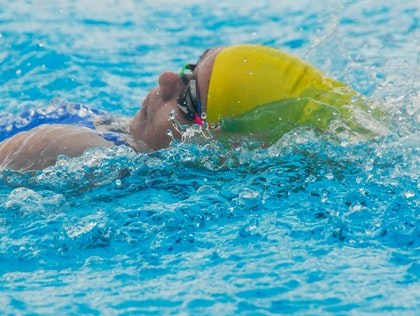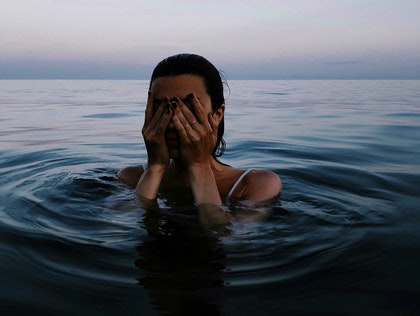Antenatal swimming, in general, is a safe form of exercise but always check this out with your Midwife, Obstetrician/ doctor before you start antenatal swimming, as you might have some medical conditions where it should be avoided.

For staying healthy, fit and well during pregnancy, a regular exercise routine is a must. Swimming while pregnant is considered safe and is a great form of low-impact aerobic exercise if there is no contraindication.
The water temperature of common heated pools is usually 30 degrees centigrade and thought to be within safe range during pregnancy (27-330C). (Ref)
You may start to learn swimming during pregnancy if there are no specific health problems where it is advisable not to do so, such as vaginal bleeding, poorly controlled epilepsy or the waters are broken (‘Spontaneous rupture of membrane’).
Staying comfortable is key for any exercise regime during pregnancy, and swimming is not an exception. You should choose a stroke that is not painful or uncomfortable. Such as pregnant women with Pelvic Girdle Pain may find breaststroke worsening their symptoms.
You can continue to swim during the entire pregnancy, ie, the first, second and third trimesters, unless you feel unwell, waters break, develop any vaginal bleeding, or any medical complication where swimming or other exercises should be avoided.
There is no evidence to show that swimming can have any adverse impact on the fetus. (Ref)
Also, the duration of swimming has also not shown to have any safety concern. (Ref)
Swimming during pregnancy is not known to cause miscarriage or preterm labour.
Is the chlorine (or other chemicals used as disinfectants) in swimming pools harmful?
Scientific research to date has not suggested that chlorine (or other chemicals used as disinfectants) in swimming pools is harmful to pregnant women or babies, or lead to a pregnancy complication. (Ref)
Swimming in the pool is considered safe. (Ref)
Advantages of swimming in pregnancy:
1. The buoyancy of water supports the weight of your bump, spine and other joints during swimming, therefore you can do more work-out with getting less exhausted.
2. There is minimal risk of trips/ falls injury while swimming and less soft tissue injury (which are more common with high impact exercise).
3. Unlike other forms of exercise, swimming keeps your body temperature low and prevents overheating.
Swimming is thought to be helpful in:
1. Reducing aches/ pains during pregnancy.
2. Improves blood circulation in the body, reducing oedema (swelling of hands and feet).
3. Distressing symptoms such as Restless Leg Syndrome
4. Improves muscle tone, stamina and endurance: this might be helpful during the labour and delivery process.
5. Relaxation, mental wellbeing, and reducing stress.
6. Pregnancy nausea and vomiting (‘morning sickness’)
7. Good workout for many important large muscles of the body.
8. Reduction of blood pressure. (ref)
Swimming during pregnancy precautions and safety tips
Safety measures to take for swimming while pregnant are the same as general precautions for performing any other antenatal exercise.
1. Always commence with shorter duration of swimming sessions and gradually increase the time during swimming
2. Allow sufficient time for the body to cool down. Like any exercise, the core body temperature can go up during pregnancy. Therefore, the cooling down period is vital.
3. Always choose strokes which are comfortable for you.
4. It is advisable that you should stop a swimming session before you feel exhausted, uncomfortable and tired.
5. Some advice to avoid breaststroke while swimming while pregnant. The ‘whip kick’ may lead to sore ligaments and backache. So speak to your swimming instructor for advice.
6. If you feel the temperature of the pool is high, please check with the swimming instructor or a member of staff in the pool.
7. Take extra care while walking on wet surfaces such as along the pool deck or the locker room to avoid slip, trip/ fall. It is advisable to wear safe footwear.
8. Avoid diving/ jumping in the pool. It is always advisable to use the ladder or the steps to enter inside the swimming pool.

9. Ensure good hydration: you may wish to keep a water bottle near the edge of the swimming pool and drink during the swimming classes.
10. Do not eat immediately before swimming, allow at least 30 minutes.
11. Avoid twisting movements during swimming as this can cause soft tissue injury and worsen Pelvic Girdle Pain.
12. No specific stroke is better or safer during pregnancy.
13. The lung capacity reduces and breathing patters changes during pregnancy, so you should allow yourself to get used to this while swimming. So it is important that you gradually increase your time in the water.
14. Water skiing and scuba diving should be avoided.
Pregnancy swimming workout
If you are a good swimmer and used to swim on a regular basis before pregnancy, you can safely continue during your pregnancy. However, in the antenatal period, it is advisable to start with shorter sessions, and then slowly building up to 30 minutes either alternate days or daily.
You may start to learn swimming during pregnancy if there are no specific health problems where it is advisable not to do so, such as vaginal bleeding, poorly controlled epilepsy or the waters are broken (‘Spontaneous rupture of membrane’).
Staying comfortable is key for any exercise regime during pregnancy, and swimming is not an exception. You should choose a stroke that is not painful or uncomfortable. Such as pregnant women with Pelvic Girdle Pain may find breaststroke worsening their symptoms.
You can continue to swim during the entire pregnancy, ie, the first, second and third trimesters, unless you feel unwell, waters break, develop any vaginal bleeding, or any medical complication where swimming or other exercises should be avoided.
Ensure a gentle routine so that you avoid being breathless after swimming.
First Trimester
Some experts say that swimming in the early hours of the morning can help relieve the ‘morning sickness’.
However, some expectant women find the smell of the chlorinated pool water itself nauseating.
You may wish to use swimming equipment’s such as noodles and/ or kickboards to support you better and enjoy your time in the water.
Second Trimester
Although it is advisable to avoid lying on your back during antenatal exercise in the land (especially after 16 weeks), swimming is different.
Backstroke is usually considered safe as the water support takes away the pressure from the spine and the large blood vessels (‘vena cava’). Therefore, there is minimal effect on the blood flow to the placenta during the backstroke during antenatal swimming.
Third Trimester
It might be more uncomfortable to swim as the pregnancy advances. A well-fitted maternity swimwear can be beneficial at this stage to support your body.
If you find it difficult to swim due to painful joints/ ligaments, you may wish to walk around in the pool, instead of swimming and take more frequent breaks.
Antenatal swimming classes
Many providers run pregnancy swimming classes in local public or private pools/ health clubs.
Please ensure a trained, qualified and experienced is running the session.
Like any other pregnancy clubs. This can be an opportunity to know other pregnant women in your local area.
Aquanatal classes
Aquanatal classes are exercise sessions in water for women during pregnancy and following childbirth. Most aqua natal classes are offered during the second and third trimesters of pregnancy.
Most of them include about an hour of exercise with music.
Usually, the classes include warm-up, stretching, aerobic exercise in water, muscle strengthening and breathing exercises.
Aqua aerobic classes
These classes involve performing aerobic exercises in swimming pools. They are also called Water Aerobics.
Certain Aqua aerobics classes are suitable for pregnant women and are run by qualified teachers.
You should inform the instructor that you are pregnant if you have been doing this prior to pregnancy. During pregnancy, you might need to alter certain movements or should avid some.
Pregnancy swimsuit
You may need a specially designed maternity swimwear during advanced pregnancy (especially during the third trimester).
Many well-known brands sell pregnancy swimsuits.
Maternity swimwear takes into account the changing shape of the body during pregnancy.
A well-fitted maternity swimming costume usually has an abdominal stretchy panel to allow extra room for the bump and a built-in supportive bra.

Swimming in the sea while pregnant
Usually, it is generally not considered unsafe to swim in open waters during pregnancy. However, a few facts regarding open water swimming needs very careful considerations. Therefore, it comes down to informed personal choice, common sense approach and sensible judgement.
There are two main challenges with open water (such as sea, river, lake, and pond) swimming:
1. Water-borne infection:
Pregnant women may be exposed to harmful germs (microorganisms) while swimming in open waters. Therefore, expectant women can be more prone to water-borne infections as the immune system can alter during pregnancy and less resistant to infections. On the other hand, swimming pools are regularly treated with disinfectants to remove them.
Common symptoms of these infections are abdominal pain and cramping, diarrhoea, and vomiting. This can lead to severe dehydration.
Swimming in cold water while pregnant:
The temperature of the water may be too cold. The temperature regulation system is less effective during pregnancy due to certain changes in the body.
This can lead to a critical drop in the core body temperature (‘hypothermia’) which can cause serious health problems. You can lose the body heat rapidly in cold water.
Precautions for open water antenatal swimming:
1. Always check any warning issued by the local government/ authorities or organisations about the water quality in the area where you are planning to swim. It is advisable to contact relevant authorities to get the data regarding the open water quality/ any recent water testing results or any outbreak of water-borne disease locally.
Learn more about Recreational Water Illness from the Centre for Disease Control and Prevention (CDC) website.
2. Contact your midwife, doctor/ Obstetrician if you know that you came in contact with contaminated water.
3. Thoroughly shower after the swimming
4. Always ensure you swim with lifeguards around, or at least you are not alone.
5. Avoid swimming while pregnant if the water is too cold or adverse weather conditions.
6. Always ensure you wear a suitable swimming costume and you have necessary training, knowledge and skills for open water swimming (especially in sea, rivers and lakes).
7. Swim close to the shore
8. Have warm clothes with you even in summer weather as you may feel cold when you get out of the water.
9. If you feel very cold/ freezing, having shivering and/ or teeth chattering, then you must get out of the water immediately. These might be signs and symptoms of hypothermia.
